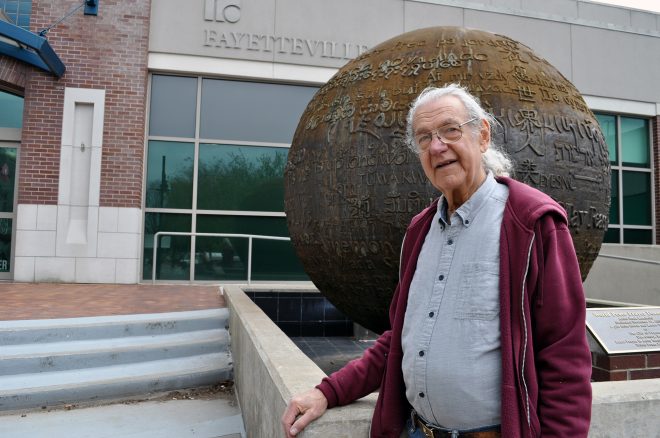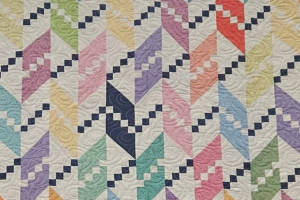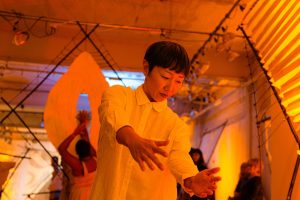Fayetteville sculptor Hank Kaminsky named 2018 Arkansas Living Treasure

The Arkansas Arts Council, a division of the Department of Arkansas Heritage, is pleased to announce that 79-year-old Hank Kaminksy of Fayetteville, an award-winning sculptor and craftsman, has been selected as the 2018 Arkansas Living Treasure.
His 60 years of artistic accomplishments, along with his dedication to teaching his craft, have earned him this distinguished title. Kaminsky will be honored at a free public reception from 5:30-7:30 p.m. on Tuesday, May 1, at the Fayetteville Town Center on 15 West Mountain St. The reception is co-sponsored by Experience Fayetteville. Space is limited; reservations are required. RSVP by April 23 to faye.croy@arkansas.gov or (501) 683-4365.
Now in its 17th year, the Arkansas Living Treasure program recognizes an Arkansan who is outstanding in the creation of a traditional craft and has significantly contributed to the preservation of the art form. An independent panel of craft and folk art professionals selects the recipient based on the quality of work, community outreach and overall contribution to the field of traditional crafts.
“We are thrilled to honor a man who has enriched the lives of so many Arkansans through the creation of his innovative and thought-provoking sculptures,” said Stacy Hurst, director of the Department of Arkansas Heritage. “It is a delight to see his public art pieces throughout the state. Arkansas is fortunate to have such a talented artist who also gives back to the community by teaching his craft to future generations.”
Since the age of 19, Kaminsky has made a living as a full-time sculptor. He creates abstract sculptures, portrait busts, plaques and medals, as well as jewelry, belt buckles and pendants, most of which are inspired by landscapes. He is probably best-known for his commissioned public art pieces, which are scattered throughout Arkansas, as well as Texas, California and Pennsylvania.
The majority of his work focuses on universal themes, such as finding world peace and discovering the secrets of life. He begins most of his sculptures in clay and casts in numerous metals, including zinc, bronze, brass and aluminum. “The most interesting technique I have used is sand casting, one of the most ancient crafts in the world,” Kaminsky said. “I sculpt because I want to discover form. My method yields a product, but I’m often surprised at what comes out.”
Though sculpture is his passion, he almost chose a different path. As a young man, Kaminsky considered a career in engineering. Born and raised in New York City, he spent a lot of time alone in his home laboratory exploring science and the world around him. “I wanted to be a scientist, and my parents encouraged that by providing toys like chemistry sets and tools that lead to the discovery of ideas.”
“I was very good with electronics,” he said. “When I graduated high school at the age of 16, I was hired by a company that made computers and radar units. He continued to study science and work in the field of science, but realized that it wasn’t as fulfilling as he had envisioned. In 1959, while attending Queens College in New York City, he changed his major from physics to art after he made his first clay sculpture.
“An artist friend of mine encouraged me to play with some clay and ‘see what happens.’ I fell in love with it,” he said. “From that point on, I knew I was going to be an artist. I became a sculptor and began a search for the secrets of life through three-dimensional art. My parents were very disappointed that I decided to give up engineering to become an artist, but they were supportive.”
He spent 10 years in school studying his craft, including the Art Students League of New York and the Pennsylvania Academy of the Fine Arts in Philadelphia. “I didn’t feel like I needed a degree though. I wasn’t looking for a job,” he said. “I was just looking to learn about the universe.”
While he was establishing himself as an artist in New York, he was invited by a colleague to visit an intentional arts community in Eureka Springs, Ark. His colleague said, “By the way, the women in Arkansas are beautiful.” He took his friend’s advice and paid a visit. And then he never left. In 1971, he moved to Eureka Springs and used his skills to set up a bronze foundry and teach classes in metal casting.
“I fell in love with the place and the people,” he said. “I tried to leave several times, but I finally met the sweetest young woman, JoAnn, who convinced me not to go. We courted, found our common grounds, married and built a home and raised two children. We thrived as artists. And we’re still doing that.”
In 1984, they moved to Fayetteville and co-founded The Art Experience, which started as a community art school. He taught sculpture classes alongside many artists in the area. In his 40s, he earned a bachelor’s degree in art with high honors from the University of Arkansas.
“It’s hard to imagine Fayetteville without Hank Kaminsky,” said Joshua Youngblood, University of Arkansas associate professor and research and outreach services librarian for special collections. “From selling his beautiful, one-of-a-kind jewelry at the farmer’s market on Saturday mornings, to the busts and pieces of ‘sacred ground’ one encounters in places of worship, academic halls and public places, to the Peace Fountain at the Town Center. Hank’s vision and belief in the power of art permeates this place, a place made more sacred for his life and work.”
The World Peace Prayer Fountain sculpture, which sits in front of the Fayetteville Town Center, is one of his most notable works of art. It is a 10-foot diameter bronze sphere with the words “May Peace Prevail on Earth” hand-sculpted on the surface in more than 100 languages.
The sculpture sits as if it’s floating in a pool and is mounted on a bearing so that anyone can spin it by hand like a prayer wheel. Interns from the University of Arkansas and individuals from the community joined Kaminsky in the creating the sculpture, which took a year-and-a-half to complete.
“The sphere symbolizes the earth, and all the prayers in more than 100 languages emanate from the center of the sphere. Water flows over the entire surface washing every language, every prayer equally. There is a sense of fluidity in the sphere itself, as each language and the structure of the sphere give the viewer a feeling of movement,” Kaminksy said.
His work has been featured in hundreds of juried exhibitions and craft shows, nationally and internationally, and is found in private collections throughout the United States.
Since 1968, he has been teaching his craft to students young and old. “I take apprentices and have entertained many a visitor in my studio. I have shown my work and demonstrated at hundreds of craft shows and have taught many aspects of my craft in my own studio and in schools such as the University of Arkansas and other institutions around the country.”





Comments